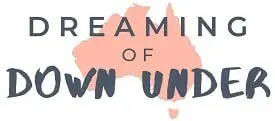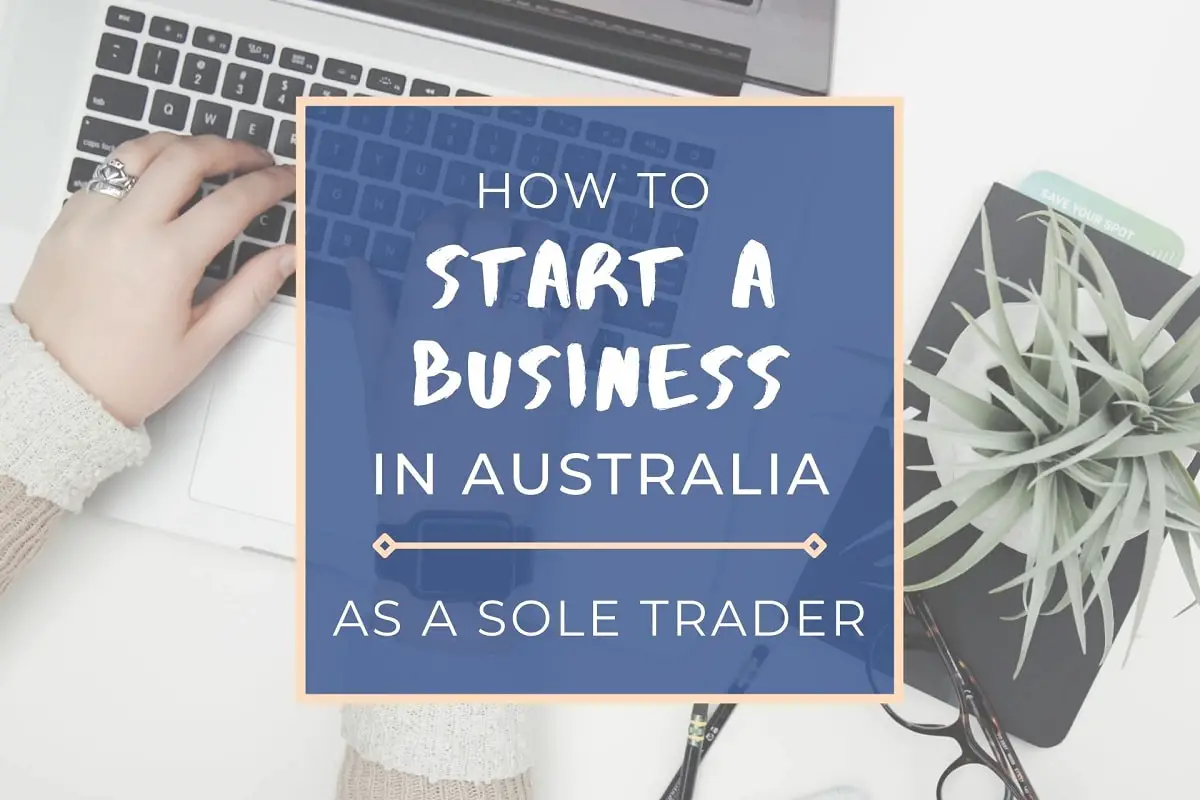This post may contain affiliate links. Please see my disclosure policy for more details.
Starting a new business can be overwhelming, particularly if you’ve moved to a new country. If you’re thinking of starting a business in Australia as a sole trader, this guide will break the process down into easy steps.
You’ll not only learn about ABN registration on the Australian Business Register (ABR) but also tips on starting a business in Australia for foreigners.
I’ve also added lots of advice on how to choose a business name, how to check if the website name you want is available, how to set up your website and where to find information on which business structure to choose.
Keep reading to get your new business venture off the ground!
Starting a Business in Australia: Table of Contents
Here are all the topics included in this guide. To skip to a specific section on starting a business in Australia, just click on the relevant link below.
Starting a Business in Australia as a Foreigner
- 1. Get the Right Visa to Start a Business in Australia
- 2. Apply for a Tax File Number (TFN)
- 3. Link Your MyGov Account to the ATO
ABN Registration Information
- 4. What is an ABN in Australia?
- 5. How Much Does an Australian ABN Cost?
- 6. ABN Registration Procedure
Choosing a Business Name & Structure
- 7. Cost to Register a Business Name in Australia
- 8. Choosing a Business Name Tips
- 9. Choosing a Business Structure
How to Register a Business in Australia as a Sole Trader
- 10. Australian Business Registration Service: Create an Account
- 11. Complete the Business Name & ABN Registration Process
- 12. Check if You Need any Business Licenses
Set up a Business Website
Starting a Business in Australia as a Foreigner
If you’re a migrant in Australia, make sure you have ticked off the following steps before setting up a business in Australia.
1. Get the Right Visa to Start a Business in Australia
If you’re not an Australian citizen or permanent resident, you’ll need a visa to work in Australia before starting a business.
To learn more, take a look at this government article on starting a business in Australia as a foreigner. There is a long list of work visas in Australia, as well as specific business visas. If you need visa advice, it’s best to contact a registered migration agent.
2. Apply for a Tax File Number (TFN)
When you move to Australia, you’ll need to apply for a Tax File Number (TFN). This is a unique, 11-digit number that the Australian Taxation Office (ATO) will use to identify you for tax or superannuation (pension) purposes.
You’ll keep your TFN for life, even if you leave Australia. You’ll also need one if you’re an employee and not a business owner.
I had a Tax File Number from a working holiday years ago, but when I immigrated to Australia, I found out my TFN had been locked. The ATO said this was to stop anyone else using it illegally, as I’d been out of the country for so long.
This meant the ATO couldn’t verify my identity initially, and I had to sort the issue out before completing my business registration application. So if you’ve had a TFN before, it’s crucial to make sure it’s reactivated.
3. Link Your MyGov Account to the ATO
You’ll also need to set up a MyGov account when you move to Australia. This is a government portal where you can login and manage things like tax returns and Medicare.
Make sure you link your MyGov account to the ATO, as during your ABN registration, the ATO will need to verify your identity.
ABN Registration & Information
Before you start setting up your business, read the following information that explains what an ABN is, the cost and why you need one.
4. What is an ABN in Australia?
ABN stands for Australian Business Number, a unique 11-digit number that will identify your business. This is different to your Tax File Number, which identifies you as a person.
You can only apply for an ABN if you are carrying on a business in Australia, and not if you are an employee of someone else’s business. You can read more detail about what an ABN is in this ATO article on what an ABN is.
5. How Much Does an Australian ABN Cost?
It is free to apply for an ABN (unless you’re paying a registered tax agent to apply on your behalf). You will have to pay if you want to register a business name though, which I’ll cover in section 7.
6. ABN Registration Procedure
To register your business on the Australian Business Register (ABR), you’ll need to use the Australian Business Registration Service. You can register a business name and ABN at the same time.
If you haven’t yet chosen a business name and structure, read the next couple of sections. Otherwise, skip straight to my section 10 on registering a business as a sole trader.
Choosing a Business Name and Structure
Since I run this blog as well as my pet care business, I have lots of experience of choosing a business name! Here are my tips, along with why you’ll need to choose right business structure.
7. How Much Does it Cost to Register a Business Name in Australia?
If you’ve chosen a business name that’s different to your own name, you’ll need to register it with the Australian Securities & Investments Commission (ASIC).
You can do this at the same time as your ABN registration, which I’ll go through in section 10.
The cost to register a business name in Australia from 1 July 2024 to 30 June 2025 is $44 for one year and $102 for three years. (Note that the fees for a company are different.)
See all current ASIC fees on the ASIC website. They usually increase the fees on July 1st each year.
8. Choosing a Business Name Tips
Before starting a business in Australia, you’ll need to decide on a business name. It’s best to carry out the research and checks below before starting the business name registration process.
Tip 1: Decide if you want a cute, funny or practical business name
Think about whether you want a simple name that clearly tells people what your business is, or whether you want a cute or funny name that plays on words.
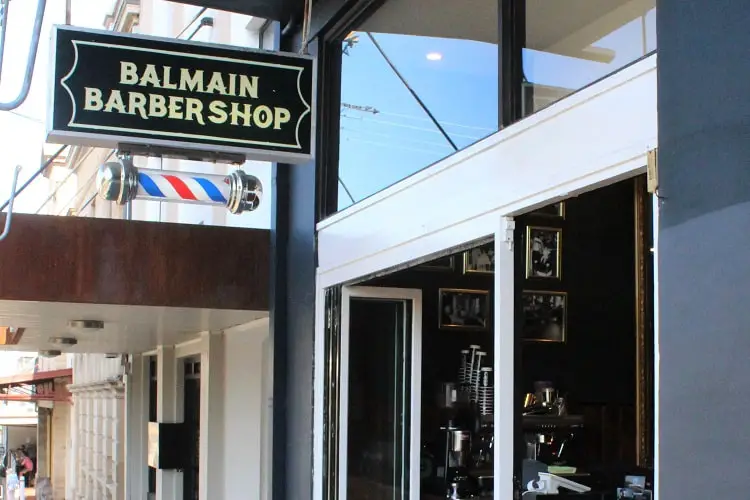
Tip 2: Does the business name allow flexibility for business expansion?
Make sure your business name allows your business to expand and doesn’t box you in. For example, if you want to sell pet products for dogs but may want to expand to sell products for other animals later on, don’t use the word “dog” in your business name!
I originally planned to integrate “pet sitter” into the name of my pet sitting business, but changed it when I decided I would stop house sitting in the future and only keep the business for other pet services like dog walking and house visits.
Tip 3: Is the business name easy to pronounce?
Make sure you say the name out loud to make sure it’s easy to pronounce, as you’ll be telling it to people face to face. The original name of this blog (Sunsets and Sarcasm) used a lot of alliteration, which was both hard to say and hard for people to understand.
Tip 4: Is the business name easy to read?
Type the name all as one word (the way it will look as a website address) and make sure the separate words are easily read at first glance. It may be that the end of one word and the start of the next word make a proper word together and throw people off.
Tip 5: Is the business name available in Australia?
Use the business name check tool on the Australian Business Registration Service to see if the business name you want is available or not. Someone else may have already used it or have an almost identical business name.
Tip 6: Is the domain name available?
The name check tool will also tell you whether the corresponding domain (website) name is available. Remember, someone could run a website with your proposed business name as a hobby (a blog, for example) without having the name registered as a business.
Even if you don’t want a website for your business now, you might in the future. So, it’s a good idea to choose a business name with an available domain name. You can also buy that domain name to stop anyone else using it, even if you don’t actually ever set up the website.
You’ll see that the name check tool checks for various domain extensions too (.com or .net etc). Note that there are rules regarding who can purchase a “.au” domain. Having a website address ending with “.com.au” shows readers that the site is for a registered Australian business.

If you decide to set up a “.com.au” website for your business, you may also want to buy the “.com” extension or other extensions to stop other people from using them. If your business will have a global audience rather than local, you may be better without “.au” at the end.
Tip 7: Check if the business name has been trademarked
Note that owning and trademarking business names are two separate procedures. Someone could have trademarked your business name even if they haven’t registered a business in that name. Use the IP Australia website to learn more and check if the business name you want has already been trademarked.
Tip 8: Check if the social media handles are available
If you want to have certain social media accounts for your business, check if the names are already taken. You may need to have a variation of your business name, for example by hyphenating the words.
9. Choosing a Business Structure
An important step before registering your business is to choose the right business structure (company, sole trader, partnership etc). You can read about the various business structures on the Australian government website.
Make sure you get professional advice if you’re not sure which business structure is right for you, as they each have different legalities, tax implications and reporting obligations. In the next section I’ll go through the business registration process for a sole trader in Australia.
How to Register a Business in Australia as a Sole Trader
If you’re ready to start setting up a business in Australia, here are the steps I took to register my own business as a sole trader, along with the relevant screenshots from my application.
10. Australian Business Registration Service: Create an Account
To begin your business name and ABN registration, follow this link to the Australian Government Business Registration Service.
Click on “Get started” in the “Register your business” section to start the application.

Next, you’ll need to select which registrations you want to apply for. As a sole trader, you’ll want to apply for both an ABN and business name.

Note that if you already have an ABN for a sole trader business but want to register a second business under the sole trader structure, you don’t need a second ABN. You can just apply for the new business name and have both businesses registered under your existing ABN (even if they’re totally separate businesses). I have two sole trader businesses registered under my one ABN.
To learn more, read about registering multiple businesses under one ABN on the Australian government website.
In the next box, you can also apply for any additional registrations that may be necessary for your business. The website has question marks next to each registration type giving further information.
None of these were applicable for my business.
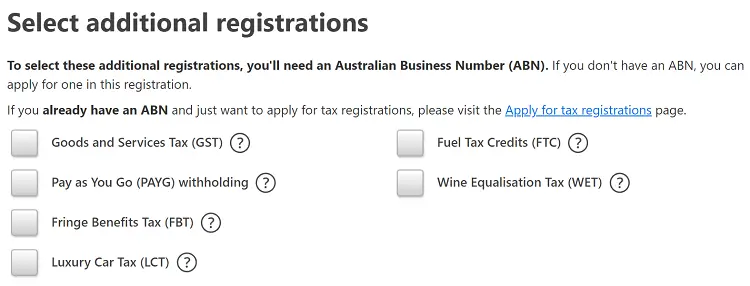
Once you click through to the next page, you’ll be notified of the cost of registering a business name with the Australian Securities & Investments Commission (ASIC) and shown the following list of information that you’ll need to complete your application.

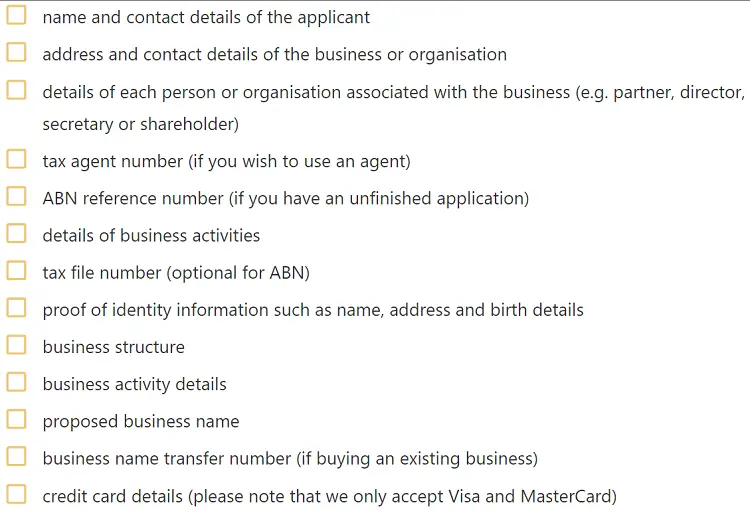
When you click through to start your application, you’ll be prompted to either sign in or create an account. Once you’ve done this you’ll be able to save your application and log back in another time if you can’t complete it in one session.
11. Complete the Business Name & ABN Registration Process
Once you’ve set up your account, the website will lead you through the steps of registering your business name and applying for an ABN.
Step 1. Getting Started
In step 1, you’ll need to choose which type of entity (business structure) you want and answer a few questions about your business. As a sole trader, I chose the “Individual” option.

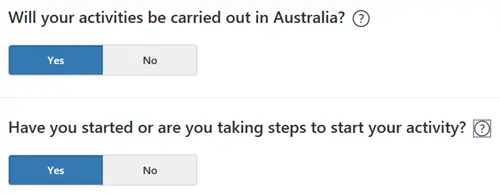
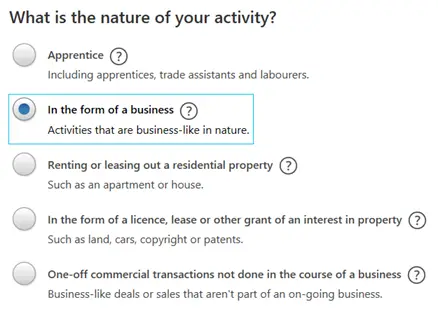

Step 2. Registering Your Business Name
Next, you can enter the business name you have chosen and select whether you want the one-year or three- year registration. You can also check that the name and domain/website address is available, if you haven’t already done this.
Note that the name may need to be referred for manual approval if it contains any “undesirable” words or expressions. A word that may have a secondary meaning that’s a bit rude, for example! One of my business names had to be manually approved, but it only took one day.
Step 3. Enter Your Business Details
The next step is to select why you need an ABN, whether it’s your first time in business in Australia and enter your personal details (name, date of birth, country of birth, tax file number and address) so that the ATO can verify your identity.

You’ll also need to select a start date for your ABN, which can be backdated up to three months, or be up to six months in the future.
You’ll then need to answer some questions about your business and enter your main business activity, as well as give your contact details and a business address.
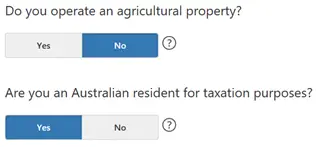
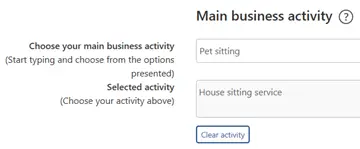
Step 4. Confirm Application
At this point, you’ll be shown a summary of all the details you’ve entered and have the chance to make amendments where necessary.

You then need to make a list of declarations before completing your application.

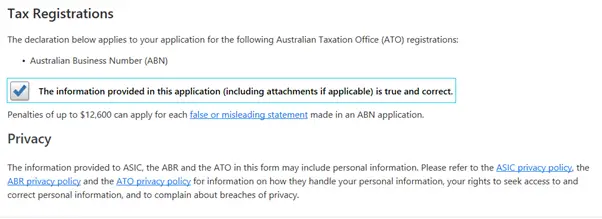
Step 5. Pay and Submit Application
You can now pay the fee to register your business name and submit your application. You’ll receive an email from the government once your application has been processed!
Step 6. Receive Business Registration Confirmation Emails
On the same day I submitted my application, I received the following four emails:
1. Confirmation that my payment had been received;
2. My Record of Registration and ASIC key;
3. An application reference for my business registration;
4. Confirmation that the status of my application had changed (i.e. accepted).
12. Check if You Need any Business Licenses
When you submit your application, you’ll be given a link to the Australian Business Licence and Information Service (ABLIS) to check if you need any other business licenses or registrations for your type of business.
I would also check if you need any specific types of insurance for your business. For example, as a pet sitter and dog walker in Australia, I’m obliged to have public liability insurance. This covers me for incidents such as a dog causing a traffic accident if someone tried to take action against me.
Set up a Business Website
Once you’ve registered your business in Australia, you can start setting up a website! Note that soon after registration, you will receive some adverts in the mail from companies trying to sell you the corresponding domain name at a very expensive price.
I really wouldn’t take up any of these offers, as I seem to remember they were over $100 per year. I only pay around $20 per year for my domain name, which is pretty standard in Australia!
The full procedure of setting up and designing a website yourself is beyond the scope of this (already very long) blog post! However, here is an overview of the first few steps you’ll need to take to start a website for your business, along with screenshots from my recommended hosting provider, SiteGround. That’s the company I use for both my websites.
I also buy my domain name through SiteGround. Remember, owning the website name that matches your business name will stop anyone else from being able to buy it.
13. Choose a Hosting Plan & Register Your Domain
When you run a website, you need to pay for both the domain name and hosting. Your host is the company who stores your web pages on their server, and every website needs one to exist. You can also buy your domain (website) name through your host.
Step 1: Choose a Hosting Plan
If you want to start setting up a website using SiteGround, click on the link below, and I will walk you through the steps:
Set up your website hosting plan with Siteground
On the SiteGround homepage, you’ll see a box called Web Hosting, like in the screenshot below. Just click on GET STARTED to begin.
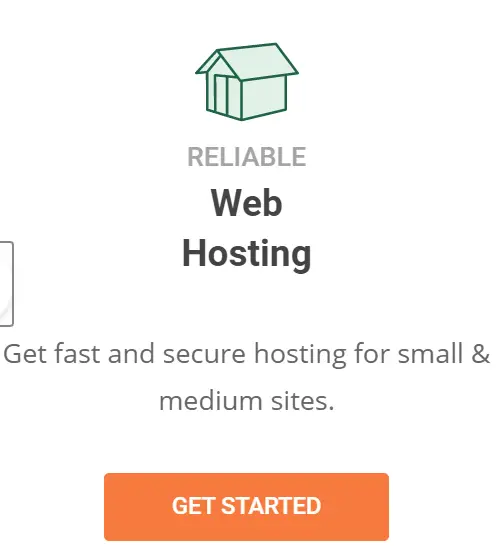
As in the screen shot below, you’ll see they offer three tiers of hosting. For a new website, you’ll only need the cheapest, “Startup” plan as you won’t have very much traffic or content yet. Click on “GET PLAN” to proceed.
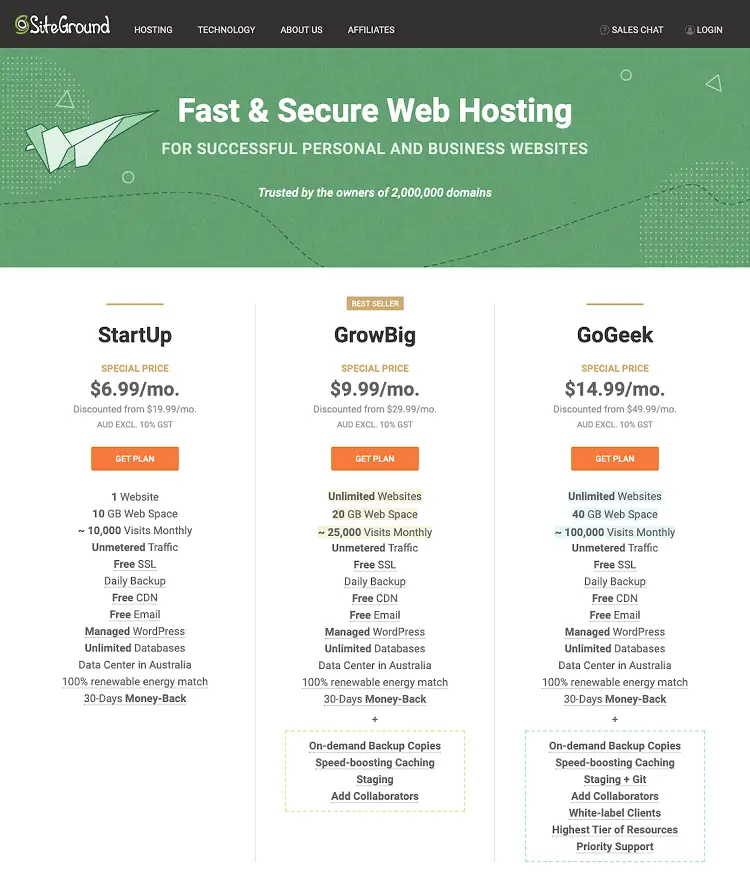
Step 2: Choose a Domain Name
After selecting your hosting plan, you can enter the domain name you want. You can see in the screenshot below that you’ll need to select whether you want to register the domain with SiteGround or whether you’ve already purchased it.
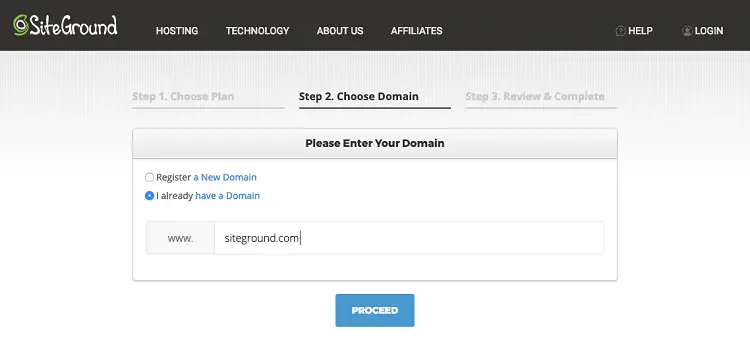
Step 3: Review & Complete Your Order
Now you can review your order and go through to payment. Note that you can choose how long your initial hosting period is. I renew mine every two years, but you can choose a shorter period. I also add on the SG Site Scanner Malware, that checks daily to see if your website has been hacked.
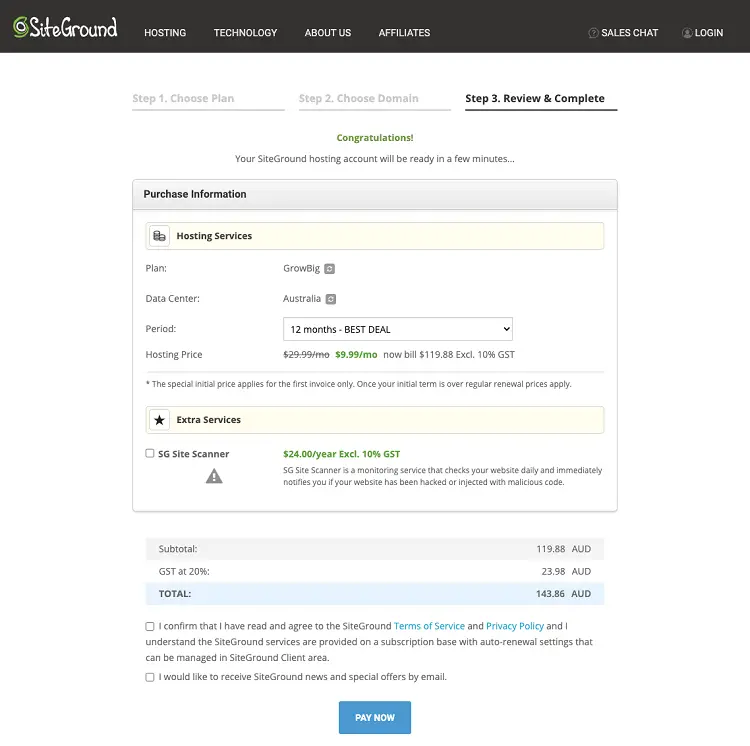
14. Install WordPress
The next step in setting up a business website is to choose a content management system (CMS). This is software that helps you create and manage the content on your website without starting from scratch using code.
The most commonly used CMS is WordPress, which is what I use for both my websites. Other options you may have heard of are Squarespace and Wix.
When you’re logged into your SiteGround account, you can choose to install WordPress on your new website and it will walk you through the process.
15. Choose a Website Theme
If you decide to use WordPress, you’ll have the choice of a few free default themes when you get set up. You can pick one of these initially and change it if you find another one you prefer.
A website theme determines how a site can look and how much you can customise it in terms of colours and styling etc.
There are thousands of different WordPress themes to choose from; some are free and some you have to pay for. I’m shortly going to be changing this website to a theme called Divi, which I’ve used to build my pet business website.
Divi is available through Elegant Themes (affiliate link – I may earn a small commission if you make a purchase) and very popular with bloggers, as it allows you to fully customise your site without needing to know any code. It’s great if you like the idea of designing your own site, with the option to change it whenever you like.
If you just want a very simple website with one page of information though, I would consider going for a cheap or free theme instead.
I hope this guide has been useful and perhaps motivated you to start your own business if it’s a dream of yours! Let me know in the comments if you’ve started a business in Australia too, or plan to in the future!
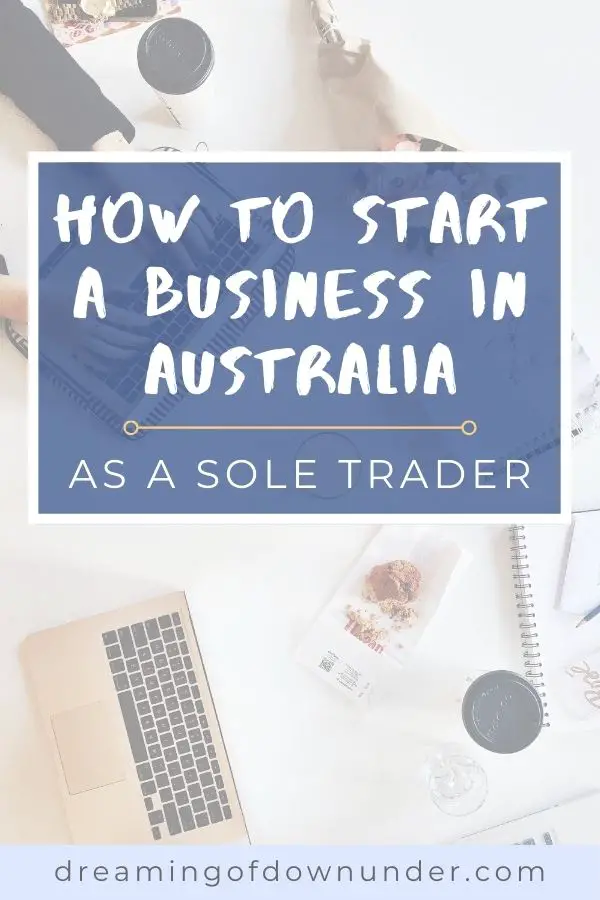

Lisa Bull, founder of Dreaming of Down Under, has been living in Australia as a British expat since 2015. After travelling to every state and territory in Australia and living in Perth, Brisbane and Sydney, Lisa knows from first-hand experience the best destinations to visit in Australia and the best budget travel tips. Her guides on this blog have been read by over 700k readers and helped thousands of people achieve their dream of living in or travelling Australia.
